List of Sri Lankan monarchs
| King of the Sinhala Kingdom | |
|---|---|
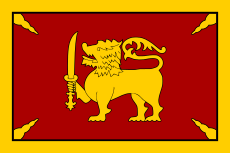 Royal Standard of the King of Kandy in 1815 | |
.jpg) Vijaya, the first Sinhalese King | |
| Details | |
| First monarch | Vijaya |
| Last monarch | Sri Vikrama Rajasinha |
| Formation | 543 BC |
| Abolition | 1815 AD |
| Residence | Tambapanni, Anuradhapura, Pulatthinagara,[1] Polonnaruwa, Dambadeniya, Gampola, Kotte, Kandy |
The Sinhalese monarch was the head of state of the Sinhala Kingdom. Anachronistically referred to as the Kings of Sri Lanka,[N 1] the monarch held absolute power and succession was hereditary. The monarchy comprised the reigning monarch, his or her family, and the royal household which supports and facilitates the monarch in the exercise of his royal duties and prerogatives.
The Sinhalese monarchy has its origins in the settlement of North Indian Indo-Aryan immigrants to the island of Sri Lanka. The Landing of Vijay as described in the traditional chronicles of the island, the Dipavamsa, Mahavamsa and Culavamsa, and later chronicles, recount the date of the establishment of the first Sinhala Kingdom in 543 BC[N 2] when Prince Vijaya (543–505 BC), an Indian Prince, and 700 of his followers landed on the island of Sri Lanka and established the Kingdom of Tambapanni.[2][3] In Sinhalese mythology, Prince Vijaya and followers are told to be the progenitors of the Sinhalese people. However, according to the story in the Divyavadana, the immigrants were probably not led by a scion of a royal house in India, as told in the romantic legend, but rather may have been groups of adventurous and pioneering merchants exploring new lands.[4]
The Sinhala Kingdom concerns the political states of the Sinhalese people and their ancestors; it existed not as one continuous state but has been historically referred to as a series of successive kingdoms known by the city at which its administrative centre was located. These are in chronological order: the kingdoms of Tambapanni, Upatissa Nuwara, Anuradhapura, Polonnaruwa, Dambadeniya, Gampola, Kotte, Sitawaka and Kandy. The kingdoms existed in what is today the modern state of Sri Lanka.[5][6][7][8] The Sinhala Kingdom ceased to exist by 1815 with Sri Vikrama Rajasinha of Kandy after generations of European influences and upheaval in the royal court. During the two millennia in which the Kingdom existed, other political entities also existed on the island, including the Jaffna Kingdom,[9] Vanni chieftaincies and the Portuguese and Dutch colonies.[10] However, these political entities were not part of the Sinhala Kingdom.
During the reign of Devanampiya Tissa (307–267 BC) saw the introduction of Buddhism to the country through Ashoka of India.[11] By the time of Kithsirimevan (304–332), Sudatta, the sub king of Kalinga, and Hemamala brought the Tooth Relic of the Buddha to Sri Lanka because of unrest in the country.[12] Kithsirimevan carried it in procession and placed the relic in a mansion named Datadhatughara.[13] He ordered this procession to be held annually, and this is still done as a tradition in the country. The Tooth Relic of the Buddha soon became one of the most sacred objects in the country, and a symbol of kingship. The person who was in possession of the Tooth Relic thereafter would be the rightful ruler of the country.[14]
The role of the monarch was absolute, he was head of state but would be aided with high level officials and a board of ministers. The monarch was seen as the supreme ruler throughout the island, even at times when he did not have absolute control over it.[15] They sought to establish control over the whole island, though in reality this was more of an aspiration. However periods of effective control over the whole island did exist from time to time.[16] The monarch also held judicial power and influence. Judicial customs, traditions and moral principles based on Buddhism were used as the bases of law. The laws and legal measures were proclaimed by the king, and were to be followed by the justice administration.[17] However the king was the final judge in legal disputes, and all cases against members of the royal family and high dignitaries of the state were judged by him. Though, the king did have to exercise this power with care and after consulting with his advisers.[18]
This article is a list of monarchs that have reigned over the nine successive kingdoms under the Sinhalese monarchy.[19][20] It is based on the traditional list of monarchs as recorded in the chronicles of the island, in particular the Mahavamsa and Rajaveliya.[21][22] It is not a list of ethnically Sinhalese monarchs. It contains all Sinhalese and foreign rulers who have reigned chronologically and in succession. Each legitimate monarch belongs to one of nine royal houses (Vijaya, Lambakanna I, Moriya, Lambakanna II, Vijayabahu, Kalinga, Siri Sanga Bo, Dinajara and Nayaks[N 3]), and follows a tradition of regnal names that span the entirety of the monarchy. For example, Vijayabahu was used 7 times over multiple kingdoms and multiple royal houses over a period of 500 years and there is no overlap of names, Vijayabahu I, II, III, IV, V, VI, VII. The same is true for Aggabodhi, Bhuvanaikabahu, Kassapa, Mahinda, Parakramabahu and others. The Sinhalese Monarchy has also been ruled over by foreigners from Southern India which has occurred several times throughout the course of the history of the kingdom. This is usually occurred through the usurpation of the throne.
Notes
This list should be used with the following factors kept in mind. Firstly, the dates provided for the earliest monarchs are difficult to objectively verify; those particularly difficult to know have been denoted with a (?) mark. Also, the island of Sri Lanka has been invaded by many foreign powers over its 2500-year history, mainly from South India, and some seized the throne and made the island part of their empires. Most notable are the Cholas in 985 and British in 1815. The Portuguese and the Dutch, however, did not seize the Kandyan throne but only occupied territory within the island.
Note on chronology
It should be borne in mind that there is controversy about the base date of the Buddhist Era, with 543 BC and 483 BC being advanced as the date of the parinibbana of the Buddha. As Wilhelm Geiger pointed out, the Dipawamsa and Mahawansa are the primary sources for ancient South Asian chronology; they date the consecration (abhisheka) of Ashoka to 218 years after the parinibbana. Chandragupta Maurya ascended the throne 56 years prior to this, or 162 years after the parinibbana. The approximate date of Chandragupta's ascension is within two years of 321 BC (from Megasthenes). Hence the approximate date of the parinibbana is between 485 and 481 BC—which accords well with the Mahayana dating of 483 BC.[23]
According to Geiger, the difference between the two reckonings seems to have occurred at sometime between the reigns of Udaya III (946–954 or 1007–1015) and Pârakkama Pandya (c. 1046–1048), when there was considerable unrest in the country.[23] However, mention is made of an embassy sent to China by Cha-cha Mo-ho-nan in 428. The name may correspond to 'Raja (King) Mahanama', who (by the traditional chronology) reigned about this time.[24]
Furthermore, the traveller-monk Xuanzang, who attempted to visit Sri Lanka about 642, was told by Sri Lankan monks (possibly at Kanchipuram) that there was trouble in the kingdom, so he desisted;[25] this accords with the period of struggle for the throne between Aggabodhi III Sirisanghabo, Jettha Tissa III and Dathopa Tissa I Hatthadpath in 632–643.
Recent indological research has indicated that the Parinibbana of the Buddha may be even later than previously supposed. A majority of the scholars at a symposium held in 1988 in Göttingen regarding the problem were inclined towards a date of 440–360 BCE. However, their calculations were based on the chronology of Tibetan Buddhism, preferred over that of the Dipavamsa/Mahavamasa; the modified chronology, to work, needs to identify the Indian ruler Kalasoka, son of Susunaga, with the Emperor Ashoka, son of Bindusara.[26] It should be noted that the Sri Lankan chronicles are based on even earlier works and that the Theravada Buddhist canon was first put into writing in Sri Lanka. The chronology of the following list is based on the traditional Therevada/Sri Lankan system, which is based on 543 BC—60 years earlier than the Mahayana calendar. Dates after c. 1048 are synchronous.
Kingdom of Tambapanni (543–505 BC)
House of Vijaya (543–505 BC)
| Portrait | Name | Birth | Death | King From | King Until | Marriages | Claim |
|---|---|---|---|---|---|---|---|
.jpg) |
Vijaya | ? Sinhapura son of Sinhabahu, and Sinhasivali |
505 BC Tambapanni |
543 BC | 505 BC | Kuveni two children Pandu Princess |
Founded Kingdom Marriage to Kuveni |
Kingdom of Upatissa Nuwara (505–377 BC)
House of Vijaya (505–377 BC)
| Portrait | Name | Birth | Death | King From | King Until | Relationship with Predecessor(s) |
|---|---|---|---|---|---|---|
| Upatissa (regent) (interregnum of one year) | - | - | 505 BC | 504 BC | *Chief Minister under Vijaya | |
| Panduvasdeva | - | - | 504 BC | 474 BC | *Nephew of Vijaya | |
| Abhaya | - | - | 474 BC | 454 BC | *Son of Panduvasdeva | |
| Tissa (regent) (interregnum of seventeen years) | - | - | 454 BC | 437 BC | *Second son of Panduvasudeva *younger brother of Abhaya | |
| Pandukabhaya | 474 BC | 367 BC | 437 BC | 377 BC | *Grandson of Panduvasudeva *Nephew of Abhaya and Tissa |
Anuradhapura Kingdom (377 BC – 1017 AD)
House of Vijaya (377–237 BC)
| Portrait | Name | Birth | Death | King From | King Until | Relationship with Predecessor(s) |
|---|---|---|---|---|---|---|
| Pandukabhaya | 474 BC | 367 BC | 377 BC | 367 BC | *Grandson of Panduvasudeva *Nephew of Abhaya and Tissa | |
| Mutasiva | - | - | 367 BC | 307 BC | *Son of Pandukabhaya | |
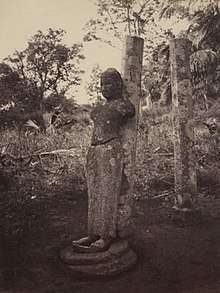 | Devanampiya Tissa | - | 267 BC | 307 BC | 267 BC | *Son of Mutasiva |
| Uttiya | - | - | 267 BC | 257 BC | *Son of Mutasiva | |
| Mahasiva | - | - | 257 BC | 247 BC | *Son of Mutasiva | |
| Suratissa | - | 237 BC | 247 BC | 237 BC | *Son of Pandukabhaya |
Sena and Guttika (237–215 BC)
| Portrait | Name | Birth | Death | King From | King Until | Claim |
|---|---|---|---|---|---|---|
| Sena and Guttika | - | - | 237 BC | 215 BC | Defeated Suratissa in battle. |
House of Vijaya (215–205 BC)
| Portrait | Name | Birth | Death | King From | King Until | Relationship with Predecessor(s) |
|---|---|---|---|---|---|---|
| Asela | ? Son of Mutasiva |
205 BC Anuradhapura |
215 BC | 205 BC | Son of Mutasiva |
Elara (205–161 BC)
| Portrait | Name | Birth | Death | King From | King Until | Claim |
|---|---|---|---|---|---|---|
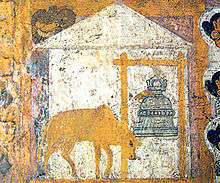 |
Elara | 235 BC Chola Empire |
161 BC Anuradhapura |
205 BC | 161 BC | Defeated Asela in battle |
House of Vijaya (161–103 BC)
| Portrait | Name | Birth | Death | King From | King Until | Relationship with Predecessor(s) |
|---|---|---|---|---|---|---|
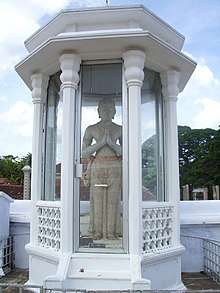 | Dutugamunu the great (a.k.a. Dutta Gamini or Dutugemunu or Duttagamini Abaya) | - | - | 161 BC | 137 BC | *Defeated Elara *Eldest son of Kavan Tissa *Originally the ruler of Ruhuna |
| Saddha Tissa | - | - | 137 BC | 119 BC | *Brother of Dutugemunu | |
| Thulatthana (Tulna) | - | - | 119 BC | 119 BC | *Second son of Saddha Tissa | |
| Lanja Tissa | - | - | 119 BC | 109 BC | *Older brother of Thullattana *Oldest son of Saddha Tissa | |
| Khallata Naga (Kalunna) | - | - | 109 BC | 104 BC | *Brother of Lanja Tissa *Third son of Saddha Tissa | |
| Vattagamani Abhaya (a.k.a. Valagambahu I) (Walagamba) | - | - | 104 BC | 103 BC | *Fourth son of Saddha Tissa |
The Five Dravidans (103–89 BC)
| Portrait | Name | Birth | Death | King From | King Until | Relationship with Predecessor(s) |
|---|---|---|---|---|---|---|
| Pulahatta | - | - | 103 BC | 100 BC | *Tamil Chief | |
| Bahiya | - | - | 100 BC | 98 BC | *Chief Minister of Pulahatha | |
| Panya Mara | - | - | 98 BC | 91 BC | *Prime Minister of Bahiya | |
| Pilaya Mara | - | - | 91 BC | 90 BC | *Chief Minister of Panayamara | |
| Dathika | - | - | 90 BC | 88 BC | *Chief Minister of Pilayamara |
House of Vijaya (89 BC – 66 AD)
| Portrait | Name | Birth | Death | King From | King Until | Relationship with Predecessor(s) |
|---|---|---|---|---|---|---|
| Vattagamani Abhaya (a.k.a. Valagambahu I) (Walagamba) | - | - | 89 BC | 76 BC | *Fourth son of Saddha Tissa | |
| Mahakuli Mahatissa (Maha Cula Maha Tissa) | - | - | 76 BC | 62 BC | *Son of Khallatanaga *Nephew and adopted son of Valagambahu I | |
| Chora Naga (Mahanaga) | - | - | 62 BC | 50 BC | *Son of Valagambahu I *Cousin of Mahakuli Mahatissa | |
| Kuda Tissa | - | - | 50 BC | 47 BC | *Son of Mahakuli Mahatissa | |
| Siva I | - | - | 47 BC | 47 BC | ||
| Vatuka | - | - | 47 BC | 47 BC | ||
| Darubhatika Tissa | - | - | 47 BC | 47 BC | ||
| Niliya | - | - | 47 BC | 47 BC | ||
| Anula | - | - | 47 BC | 42 BC | *Widow of Chora Naga and Kuda Tissa | |
| Kutakanna Tissa | - | - | 42 BC | 20 BC | *Brother of Kuda Tissa *Second son of Mahakuli Mahatissa | |
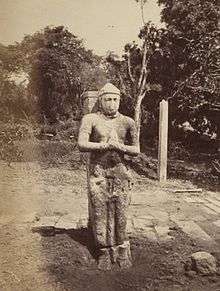 | Bhatikabhaya Abhaya | - | - | 20 BC | 9 AD | *Son of Kuttakanna Tissa |
| Mahadathika Mahanaga | - | - | 9 | 21 | *Brother of Bhatika Abhaya | |
| Amandagamani Abhaya | - | - | 21 | 30 | *Son of Mahadathika Mahanaga | |
| Kanirajanu Tissa | - | - | 30 | 33 | *Brother of Amandagamani Abhaya | |
| Chulabhaya | - | - | 33 | 35 | *Son of Amandagamani Abhaya | |
| Sivali | - | - | 35 | 35 | *Sister of Chulabhaya | |
| Interregnum | - | - | 35 | 38 | ||
| Ilanaga (Elunna) | - | - | 38 | 44 | *Nephew of Queen Sivali | |
| Chandamukha | - | - | 44 | 52 | *Son of Ilanaga | |
| Yassalalaka | - | - | 52 | 60 | *Younger brother of Candhamuka Siva | |
| Subharaja (a.k.a. Subha) | - | - | 60 | 66 | *The hall porter of King Yasalaka Tissa |
House of Lambakanna I (66–436)
| Portrait | Name | Birth | Death | King From | King Until | Relationship with Predecessor(s) |
|---|---|---|---|---|---|---|
| Vasabha | - | - | 66 | 110 | *A member of the Lambakanna clan | |
| Vankanasika Tissa | - | - | 110 | 113 | *Son of Vasabha | |
| Gajabahu I | - | - | 113 | 135 | *Son of Vankanasika Tissa | |
| Mahallaka Naga | - | - | 135 | 141 | *Father-in-Law of Gajabahu I | |
| Bhatika Tissa | - | - | 141 | 165 | *Son of Mahallaka Naga | |
| Kanittha Tissa | - | - | 165 | 193 | *Younger brother of Bhatika Tissa | |
| Cula Naga (a.k.a. Khujjanaga) | - | - | 193 | 195 | *Son of Kanitta Tissa | |
| Kuda Naga (a.k.a. Kunchanaga) | - | - | 195 | 196 | *Brother of Cula Naga | |
| Siri Naga I | - | - | 196 | 215 | *Brother-in-Law of Kuda Naga | |
| Voharika Tissa (a.k.a. Vira Tissa & Voharikathissa) | - | - | 215 | 237 | *Son of Siri Naga I | |
| Abhaya Naga | - | - | 237 | 245 | *Brother of Voharaka Tissa | |
| Siri Naga II | - | - | 245 | 247 | *Son of Voharaka Tissa | |
| Vijaya Kumara | - | - | 247 | 248 | *Son of Siri Naga II | |
| Sangha Tissa I | - | - | 248 | 252 | *A Lambakanna | |
| Siri Sangha Bodhi I (a.k.a. Siri Sangabo) | - | - | 252 | 254 | *A Lambakanna | |
| Gothabhaya | - | - | 254 | 267 | *Minister of State *A Lambakanna | |
| Jettha Tissa I (a.k.a. Detuthis I) | - | - | 267 | 277 | *Eldest son of Gothabhaya | |
| Mahasena | - | - | 277 | 304 | *Brother of Jettha Tissa *Younger son of Gothabhaya | |
| Sirimeghavanna | - | - | 304 | 332 | *Son of Mahasena | |
| Jettha Tissa II | - | - | 332 | 341 | *Brother of Sirimeghavanna | |
| Buddhadasa | - | - | 341 | 370 | *Son of Jettha Tissa II | |
| Upatissa I | - | - | 370 | 412 | *Eldest son of Buddhadasa | |
| Mahanama | - | - | 412 | 434 | *Brother of Upatissa I | |
| Soththisena | - | - | 434 | 434 | *Mahanama's son born to a Tamil mother | |
| Chattagahaka Jantu (a.k.a. Chhattagahaka) | - | - | 434 | 435 | *Husband of Sangha *Daughter of Mahanama by his Sinhala Queen | |
| Mittasena | - | - | 435 | 436 | *A noted plunderer |
The Six Dravidians (436–463)
| Portrait | Name | Birth | Death | King From | King Until | Relationship with Predecessor(s) |
|---|---|---|---|---|---|---|
| Pandu | - | - | 436 | 441 | *Pandyan Invader | |
| Parindu | - | - | 441 | 441 | *Son of Pandu | |
| Khudda Parinda | - | - | 441 | 447 | *Younger brother of Pandu | |
| Tiritara | - | - | 447 | 447 | *Fourth Tamil ruler | |
| Dathiya | - | - | 447 | 450 | *Fifth Tamil ruler | |
| Pithiya | - | - | 450 | 452 | *Sixth Tamil ruler |
House of Moriya (463–691)
| Portrait | Name | Birth | Death | King From | King Until | Relationship with Predecessor(s) |
|---|---|---|---|---|---|---|
| Dhatusena | - | - | 463 | 479 | *Son of Sangha, the daughter of Mahanama *Liberated Anuradhapura from 27 years of Pandyan Rule | |
| Kashyapa I (the Usurper),(of Sigiriya) | - | - | 479 | 497 | *Son of King Dhatusena by a Pallava woman | |
| Moggallana I | - | - | 497 | 515 | *Son of Dhatusena *Brother of Kasyapa | |
| Kumara Dhatusena | - | - | 515 | 524 | *Son of Mogallana | |
| Kittisena | - | - | 524 | 524 | *Son of Kumara Dhatusena | |
| Siva II | - | - | 524 | 525 | *Uncle of Kirti Sena | |
| Upatissa II | - | - | 525 | 526 | *Son-in-Law of Kumara Dhatusena | |
| Silakala Ambosamanera | - | - | 526 | 539 | *A prince of Lambakanna stock | |
| Dathappabhuti | - | - | 539 | 540 | *Second son of Silakala | |
| Moggallana II | - | - | 540 | 560 | *Eldest brother of Dathapatissa | |
| Kittisiri Meghavanna | - | - | 560 | 561 | *Son of Mogallana II | |
| Maha Naga | - | - | 561 | 564 | *Minister of War under King Dathapatissa | |
| Aggabodhi I | - | - | 564 | 598 | *Brother of Mahanaga *Nephew and Sub-King of Mahanaga | |
| Aggabodhi II | - | - | 598 | 608 | *Nephew and son-in-law of Aggabodhi I | |
| Sangha Tissa II | - | - | 608 | 608 | *Brother and Sword-bearer of Aggabodhi II | |
| Moggallana III | - | - | 608 | 614 | *Commander-in-Chief during the reign of Aggabodhi II | |
| Silameghavanna | - | - | 614 | 623 | *King Mogallana's Sword-bearer | |
| Aggabodhi III | - | - | 623 | 623 | *Son of Silimeghavanna | |
| Jettha Tissa III | - | - | 623 | 624 | *Son of King Sangha Tissa | |
| Aggabodhi III (restored) | - | - | 624 | 640 | *Son of Silimeghavanna | |
| Dathopa Tissa I (Hatthadpatha) | - | - | 640 | 652 | *General of Jettha Tissa (Dathasiva) | |
| Kassapa II | - | - | 652 | 661 | *Brother of Agbo II *Sub-King of Dathopa Tissa | |
| Dappula I | - | - | 661 | 664 | *Son in law of Silimeghavanna | |
| Dathopa Tissa II | - | 673 | 664 | 673 | *Nephew of Dathopa Tissa I (Hattha Datha) | |
| Aggabodhi IV | - | - | 673 | 689 | *Younger brother of Dathopa Tissa | |
| Unhanagara Hatthadatha | - | - | 691 | 691 | *A chief of Royal blood who was placed on the throne by a wealthy Tamil Officer |
House of Lambakanna II (691–1017)
| Portrait | Name | Birth | Death | King From | King Until | Relationship with Predecessor(s) |
|---|---|---|---|---|---|---|
| Manavanna | - | - | 691 | 726 | *Son of Kassapa I *Descendant of Silamegahavanna | |
| Aggabodhi V | - | - | 726 | 732 | *Son of Manavamma | |
| Kassapa III | - | - | 732 | 738 | *Brother of Aggabodhi V | |
| Mahinda I | - | - | 738 | 741 | *Younger brother of Kassapa III | |
| Aggabodhi VI | - | - | 741 | 781 | *Son of Kassapa III | |
| Aggabodhi VII (From Polonnaruwa) | - | - | 781 | 787 | *Son of Mahinda | |
| Mahinda II (Silamegha) | - | - | 787 | 807 | *Son of Aggabodhi VI | |
| Dappula II | - | - | 807 | 812 | *Son of Mahinda II *The sub-king of Mahinda II | |
| Mahinda III | - | - | 812 | 816 | *Son of Dappula II | |
| Aggabodhi VIII | - | - | 816 | 827 | *Brother of Mahinda III | |
| Dappula III | - | - | 827 | 843 | *Younger brother of Aggabodhi VIII | |
| Aggabodhi IX | - | - | 843 | 846 | *Son of Dappula III | |
| Sena I | - | - | 846 | 866 | *Younger brother of Aggabodhi IX | |
| Sena II | - | - | 866 | 901 | *Nephew of Sena I *Son of Kassapa | |
| Udaya I | - | - | 901 | 912 | *Brother of sub-king of Sena II | |
| Kassapa IV | - | - | 912 | 929 | *Son of Sena II *Sub-king of Udaya I | |
| Kassapa V | - | - | 929 | 939 | *Son of Kassapa IV | |
| Dappula IV | - | - | 939 | 940 | *Son of Kassapa V | |
| Dappula V | - | - | 940 | 952 | *Brother of Dappula IV | |
| Udaya II | - | - | 952 | 955 | *Nephew of Sena II *Sub-king of Dappula V | |
| Sena III | - | - | 955 | 964 | *Brother of Udaya II | |
| Udaya III | - | - | 964 | 972 | *Sub-king of Sena III (a great friend of the king) | |
| Sena IV | - | - | 972 | 975 | *Son of Kassapa V *Sub-king of Udaya III | |
| Mahinda IV | - | - | 975 | 991 | *Brother of Sena IV *Nephew of Udaya III *Sub-king of Sena | |
| Sena V | - | - | 991 | 1001 | *Son of Mahinda IV | |
| Mahinda V (Fled and ruled in Ruhuna) (Deported c. 1017) | - | 1029 | 1001 | 1017 | *Younger brother of Sena V |
Chola-occupied Anuradhapura (1017–1070)
Chola Dynasty (1017–1070)
| Portrait | Name | Birth | Death | King From | King Until | Relationship with Predecessor(s) |
|---|---|---|---|---|---|---|
| Rajendra Chola I | - | 1044 | 1017 | 1044 | *Son of Raja Raja Chola I *Made the occupied areas a province of the Chola empire | |
| Rajadhiraja Chola | - | 1054 | 1018 | 1054 | *Son of Rajendra | |
| Rajendra Chola II | - | 1063 | 1051 | 1063 | *Son of Rajendra | |
| Virarajendra Chola | - | 1070 | 1063 | 1070 | *Son of Rajendra | |
| Athirajendra Chola | - | 1070 | 1067 | 1070 | *Son of Virarajendra Chola |
Kingdom of Polonnaruwa (1056–1236)
House of Vijayabahu (1056–1187)
| Portrait | Name | Birth | Death | King From | King Until | Relationship with Predecessor(s) |
|---|---|---|---|---|---|---|
| Vijayabahu I | - | - | 1056 | 1111 | *Member of the Sinhala Royal Family | |
| Jayabahu I (Polonnaruwa and Ruhuna) | - | - | 1110 | 1111 | *Brother of Vijayabahu I *Prime Minister of Vijayabahu I | |
| Vikramabahu I | - | 1132 | 1111 | 1132 | *Son of Vijayabahu I | |
| Gajabahu II | - | - | 1131 | 1153 | *Son of Vikramabahu I | |
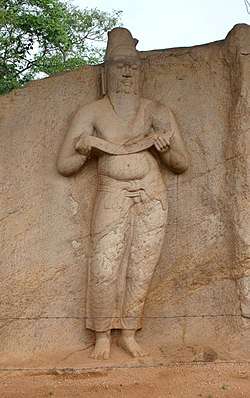 | Parakramabahu I 'the Great' | 1123 | 1186 | 1153 | 1186 | *Grandson of Vijayabahu I |
| Vijayabahu II | - | - | 1186 | 1187 | *Parakramabahu I's nephew | |
| Mahinda VI | - | - | 1187 | 1187 | *A Kalinga |
House of Kalinga (1187–1197)
| Portrait | Name | Birth | Death | King From | King Until | Relationship with Predecessor(s) |
|---|---|---|---|---|---|---|
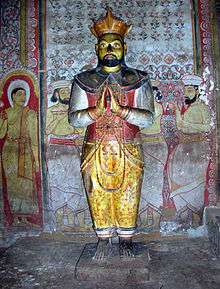 | Nissanka Malla | 1157 or 1158 | 1196 | 1187 | 1196 | *Son-in-law or nephew to Parakrama Bahu I |
| Vira Bahu I | - | - | 1196 | 1196 | *Son of Nissanka Malla | |
| Vikramabahu II | - | - | 1196 | 1196 | *Younger brother of Nissanka Malla | |
| Chodaganga | - | - | 1196 | 1197 | *Nephew of Nissanka Malla |
House of Vijayabahu, restored (1197–1200)
| Portrait | Name | Birth | Death | King From | King Until | Relationship with Predecessor(s) |
|---|---|---|---|---|---|---|
| Queen Lilavati | - | - | 1197 | 1200 | *Widow of Parakramabahu I |
House of Kalinga, restored (1200–1209)
| Portrait | Name | Birth | Death | King From | King Until | Relationship with Predecessor(s) |
|---|---|---|---|---|---|---|
| Sahassa Malla | - | - | 1200 | 1202 | *Younger brother of Nissanka Malla | |
| Kalyanavati | - | - | 1202 | 1208 | *Queen of Nissanka Malla | |
| Dharmasoka | - | - | 1208 | 1209 | *Deposed Kalyanavati and installed by Ayasmantha | |
| Anikanga | - | - | 1209 | 1209 | *Father of Dharmasoka |
House of Vijayabahu, restored (1209–1210)
| Portrait | Name | Birth | Death | King From | King Until | Relationship with Predecessor(s) |
|---|---|---|---|---|---|---|
| Lilavati (1st Restoration) | - | - | 1209 | 1210 | *Widow of Parakramabahu I |
Lokissara (1210–1211)
| Portrait | Name | Birth | Death | King From | King Until | Relationship with Predecessor(s) |
|---|---|---|---|---|---|---|
| Lokissara | - | - | 1210 | 1211 | Leader of a Tamil army. |
House of Vijayabahu, restored (1211–1212)
| Portrait | Name | Birth | Death | King From | King Until | Relationship with Predecessor(s) |
|---|---|---|---|---|---|---|
| Lilavati (2nd Restoration) | - | - | 1211 | 1212 | *Widow of Parakramabahu I |
Pandyan dynasty (1212–1215)
| Portrait | Name | Birth | Death | King From | King Until | Relationship with Predecessor(s) |
|---|---|---|---|---|---|---|
| Parakrama Pandya | - | - | 1212 | 1215 | *Pandyan King |
Eastern Ganga dynasty (1215–1236)
After Kalinga Magha invaded, with the intent of ruling the whole island, the Kingdom of Polonnaruwa was sacked. This caused massive Sinhalese migration to the south and west of the island. Unable to capture the whole island Kalinga Magha establishes the Jaffna kingdom becoming its first monarch. The Jaffna kingdom is situated in modern northern Sri Lanka while the Kingdom of Dambadeniya was established by Vijayabahu III on the rest of the island in around 1220.[27]
| Portrait | Name | Birth | Death | King From | King Until | Relationship with Predecessor(s) |
|---|---|---|---|---|---|---|
| Kalinga Magha | - | - | 1215 | 1236 | *A prince of Kalinga |
Kingdom of Dambadeniya (1220–1345)
House of Siri Sanga Bo (1220–1345)
| Portrait | Name | Birth | Death | King From | King Until | Relationship with Predecessor(s) |
|---|---|---|---|---|---|---|
| Vijayabahu III | - | - | 1220 | 1224 | *A patriotic Prince of Sinhala Royal blood | |
| Parakkamabahu II | - | - | 1234 | 1269 | *Eldest son of Vijaya Bahu III | |
| Vijayabahu IV | - | October 1270 | 1267/8 | October 1270 | *Eldest son of Panditha Parakrama Bahu II | |
| Bhuvanaikabahu I (from Yapahuwa) | - | - | 1271 | 1283 | *Brother of Vijaya Bahu IV | |
| Interregnum | - | - | 1283 | 1302 | ||
| Parakkamabahu III (from Polonnaruwa) | - | - | 1302 | 1310 | *Nephew of Buvaneka Bahu I *Son of Vijaya Bahu IV | |
| Bhuvanaikabahu II (from Kurunagala) | - | - | 1310 | 1325/6 | *Son of Buvaneka Bahu I *Cousin of Parakrama Bahu III | |
| Parakkamabahu IV (from Kurunagala) | - | - | 1325/6 | 1325/6 | *Son of Buvanekka Bahu II | |
| Bhuvanaikabahu III (from Kurunagala) | - | - | 1325/6 | 1325/6 | *Known as Vanni Buvaneka Bahu | |
| Vijayabahu V (from Kurunagala) | - | - | 1325/6 | 1344/5 | *Second son of Chandra Banu of Jaffnapatnam |
Kingdom of Gampola (1345–1412)
House of Siri Sanga Bo (1345–1412)
| Portrait | Name | Birth | Death | King From | King Until | Relationship with Predecessor(s) |
|---|---|---|---|---|---|---|
| Bhuvanaikabahu IV | - | - | 1344/5 | 1353/4 | *Son of Vijaya Bahu V | |
| Parakkamabahu V (from Dedigama) | 1311 | - | 1344/5 | 1359 | *Son of Vijaya Bahu V *Brother of Buvaneka Bahu IV | |
| Vikramabahu III | - | - | 1357 | 1374 | *Son of Buvaneka Bahu IV | |
| Bhuvanaikabahu V | - | - | 1372/3 | 1391/2 | *Nissanka Alakeswara's son by the sister of Vikrama Bahu III | |
| Vira Bahu II | - | - | 1391/2 | 1397 | *Brother in law of King Buvaneka Bahu V | |
| Son of Vira Bahu II | - | - | 1397 | 1397 | *Son of Vira Bahu II | |
| Son of Vira Bahu II | - | - | 1397 | 1397 | *Son of Vira Bahu II | |
| Vira Alakesvara (a.k.a. Vijaya Bahu VI) | - | - | 1397 | 1409 | ||
| Parakrama Bahu Epa | - | - | 1409 | 1412 | *Grandson of Senalankahikara Senevirat minister of Bhuvanaikabâhu IV. |
Kingdom of Kotte (1412–1597)
House of Siri Sanga Bo (1412–1597)
| Portrait | Name | Birth | Death | King From | King Until | Relationship with Predecessor(s) |
|---|---|---|---|---|---|---|
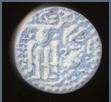 | Parakramabahu VI | - | - | 1412 | 1467 | *Son of Vijaya Bahu VI and his Queen Sunetra Devi *Or the third son of Chandra Banu of Yapa Patuna (Jaffnapatnam) |
 | Jayabahu II (Vira Parakrama Bahu VII) | - | - | 1467 | 1472 | *Son of Parakrama Bahu II's natural daughter, Ulakudaya Devi |
 | Bhuvanekabahu VI (a.k.a. Sapumal Kumara) | - | - | 1472 | 1480 | *Son of Parakrama Bahu VI |
 | Parakramabahu VII | - | - | 1480 | 1484 | |
 | Parakramabahu VIII | - | - | 1484 | 1518 | *Ambulagala Kumara *Son of Parakrama Bahu VI |
 | Dharma Parakramabahu IX (from Kelaniya) | - | - | 1509 | 1528 | *Son of Vira Parakrama Bahu VIII |
 | Vijayabahu VII | - | 1521 | 1509 | 1521 | *Brother of Dharma Parakrama Bahu IX *Rajah of Menik Kadavara |
 | Bhuvanekabahu VII | - | 1551 | 1521 | 1551 | *Eldest son of Vijaya Bahu |
 | Dharmapala (a.k.a. Dom Joaõ Dharmapala) | - | May 27, 1597 | 1551 | May 27, 1597 | *Grandson and heir of Bhuvanekabãhu VII |
Kingdom of Sitawaka (1521–1593)
House of Siri Sanga Bo (1521–1593)
| Portrait | Name | Birth | Death | King From | King Until | Relationship with Predecessor(s) |
|---|---|---|---|---|---|---|
.png) | Mayadunne | 1501 | 1581 | 1521 | 1581 | *Brother of Bhuvaneka Bahu VII *Son of Vijaya Bahu VII |
 | Rajasinha I (a.k.a. Tikiri Banda) | 1544 | 1593 | 1581 | 1593 | *Son of Mayadunne |
Kingdom of Kandy (1590–1815)
House of Dinajara (1590–1739)
| Portrait | Name | Birth | Death | King From | King Until | Relationship with Predecessor(s) |
|---|---|---|---|---|---|---|
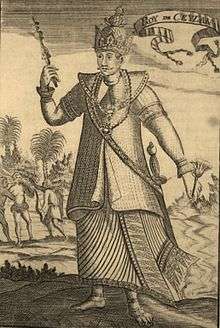 | Vimaladharmasuriya I (a.k.a. Don João da Austria) | - | 1604 | 1590 | 1604 | *Son of Vijayasundara Bandara |
| Senarat | - | 1635 | 1604 | 1635 | *Cousin of Vimala Dharma Suriya I | |
.jpg) | Rajasinghe II | 1608 | 6 December 1687 | 1635 | November 25, 1687 | *Son of Senarat and Dona Catherina |
| Vimaladharmasurya II | - | June 4, 1707 | 1687 | June 4, 1707 | *Son of King Rajasinghe II | |
| Vira Narendra Sinha (a.k.a. Sri Vira Parakrama Narendra Singha) | 1690 | 13 May 1739 | June 4, 1707 | 13 May 1739 | *Son of Vimala Dharma Suriya II |
House of Kandy Nayakar (1739–1815)
| Portrait | Name | Birth | Death | King From | King Until | Marriages | Relationship with Predecessor(s) |
|---|---|---|---|---|---|---|---|
.svg.png) |
Sri Vijaya Rajasinha | ? Madurai, Madurai Nayak dynasty son of Pitti Nayakkar |
11 August 1747 Kandy |
13 May 1739 | 11 August 1747 | 1 Madurai Spouse | Brother-in-law of Vira Narendra Sinha |
.svg.png) |
Kirti Sri Rajasinha | 1734 Madurai, Madurai Nayak dynasty son of Narenappa Nayakkar |
2 January 1782 Kandy |
11 August 1747 | 2 January 1782 | 6 Madurai Spouses Yakada Doli 2 sons, 6 daughters |
Brother-in-law of Sri Vijaya Rajasinha |
.svg.png) |
Sri Rajadhi Rajasinha | ? Madurai son of Narenappa Nayakkar |
26 July 1798 Kandy |
2 January 1782 | 26 July 1798 | Queen Upendramma | Brother of Kirti Sri Rajasinha |
 |
Sri Vikrama Rajasinha (a.k.a. Rajasinha IV; Kannasamy) |
1780 Madurai son of Sri Venkata Perumal and Subbamma Nayaka |
30 January 1832 Vellore Fort, Company rule in India |
26 July 1798 | 5 March 1815 | 4 spouses 3 children |
Nephew of Sri Rajadhi Rajasinha |
End of monarchy
In 1796 the British first entered the island and gained control of the coastal areas from the Dutch. After the Kandyan Wars and the signing of the Kandyan Convention in 1815 the island recognized the British monarch as Sovereign, ending over 2000 years of Sri Lankan indigenous monarchy.
Timeline

Notes
References
- ↑ "Anurādhapura". www.palikanon.com. Retrieved 27 February 2013.
- ↑ Mittal (2006) p 405
- ↑ "483 BC – Arrival of Aryans to Sri Lanka". scenicsrilanka.com. Retrieved 2009-11-06.
- ↑ Cavendish, Marshall (2007). World and Its Peoples: Eastern and Southern Asia. Cavendish Square Publishing. pp. 350–51. ISBN 978-0761476313.
- ↑ Bandaranayake, S. D. (1974). Sinhalese Monastic Architecture: The Viháras of Anurádhapura. Leiden: BRILL. p. 17. ISBN 9004039929.
- ↑ De Silva, K. M. (1981). A History of Sri Lanka. University of California Press. ISBN 978-0195616552.
- ↑ Blaze, L. E. (1938). History of Ceylon. Asian Educational Services. ISBN 978-8120618411.
- ↑ Manogaran, Chelvadurai (1987). Ethnic Conflict and Reconciliation in Sri Lanka. University of Hawaii Press. pp. 25–26. ISBN 978-0824811167.
- ↑ Malalgoda, Kitsiri (1976). Buddhism in Sinhalese Society, 1750-1900: A Study of Religious Revival and Change. University of California Press. p. 29. ISBN 0520028732.
- ↑ Mendis (1999), p. 11
- ↑ Blaze (1995), p. 58
- ↑ Wijesooriya (2006), p. 89
- ↑ Blaze (1995), p. 59
- ↑ Perera (2001), p. 48
- ↑ De Silva (1981), p. 21
- ↑ Rambukwelle (1993), p. 38
- ↑ Siriweera (2004), p. 92
- ↑ Ratnatunga, Rhajiv. "LIST OF THE SOVEREIGNS OF LANKA". lakdiva.org. Retrieved 1 January 2018.
- ↑ de Silva, K. M. (2005). A History of Sri Lanka. Sri Lanka: Penguin Books India. Retrieved 1 January 2018.
- ↑ Gunasekara, B. (1900). The Rajavaliya : or, A historical narrative of Sinhalese kings from Vijaya to Vimala Dharma Surya II. Colombo: Government Printer, Ceylon. ISBN 81-206-1029-6. Retrieved 1 January 2018.
- ↑ "The Mahavamsa: Original Version Chapters 1 – 37". Mahavamsa.org. Retrieved 27 February 2013.
- 1 2 Geiger (Tr), Wilhelm (1912). The Mahawamsa or Great Chronicle of Ceylon. Oxford: Oxford University Press (for the Pali Text Society). p. 300. Archived from the original on 2008-10-30.
- ↑ S G M Weerasinghe, A history of the cultural relations between Sri Lanka and China: an aspect of the Silk Route, Colombo: Central Cultural Fund, 1995, ISBN 955-613-055-1, p.40
- ↑ Stephen Spencer Gosch, Peter N. Stearns, Premodern Travel in World History, Routledge, 2008; ISBN 0-415-22940-5, p.93
- ↑ Cousins, L. S. "The Dating of the Historical Buddha: A Review Article". indology. Retrieved 27 February 2013.
- ↑ Codrington, Humphry William. "The Dambadeniya And Gampola Kings". lakdiva.org. Retrieved 27 February 2013.
Further reading
Primary sources
- Dhammakitti; tr. Geiger, Wilhelm; tr. Rickmers, C. Habel (1212). Culavamsa: Being the More Recent part of the Mahavamsa (1929 ed.). Colombo: Ceylon Govt. Information Dept.
- tr. Geiger, Wilhelm; Bode, Mabel Haynes (1912). Mahavamsa : the great chronicle of Ceylon. London: Oxford University Press.
- ed. Gunasekara, B. (1900). The Rajavaliya : or, A historical narrative of Sinhalese kings from Vijaya to Vimala Dharma Surya II. Colombo: Government Printer, Ceylon. ISBN 81-206-1029-6.
- Knox, Robert (1681). An Historical Relation of the Island Ceylon. London: Richard Chiswell.
- ed. & tr. Oldenberg, Hermann (1879). The Dîpavaṃsa, an Ancient Buddhist Historical Record. Williams and Norgate.
Secondary sources
- De Silva, K. M. (1981). A History of Sri Lanka. India: University of California Press. ISBN 0-520-04320-0.
- Blaze, L. E (1995). History of Ceylon. Asian Educational Services. ISBN 978-81-206-1074-3.
- de Silva, K. M. (2005). A History of Sri Lanka. Colombo: Vijitha Yapa. p. 782. ISBN 955-8095-92-3.
- Mendis, Ranjan Chinthaka (1999). The Story of Anuradhapura. Lakshmi Mendis. ISBN 978-955-96704-0-7.
- Mittal, J. P. (2006). "Other dynasties". History of Ancient India: From 4250 BC to 637 AD. Volume 2 of History of Ancient India: A New Version. Atlantic Publishers & Distributors. ISBN 81-269-0616-2.
- Nicholas, C. W.; Paranavitana, S. (1961). A Concise History of Ceylon. Colombo University Press.
- Perera, Lakshman S. (2001). The Institutions of Ancient Ceylon from Inscriptions. 1. International Centre for Ethnic Studies. ISBN 978-955-580-055-6.
- Rambukwelle, P. B. (1993). Commentary on Sinhala Kingship — Vijaya to Kalinga Magha. Sridevi Printers. ISBN 978-955-95565-0-3.
- Siriweera, W. I. (2004). History of Sri Lanka. Dayawansa Jayakodi & Company. ISBN 978-955-551-257-2.
- Wijesooriya, S. (2006). A Concise Sinhala Mahavamsa. Participatory Development Forum. ISBN 978-955-9140-31-3.
- Paranavithana, Senarath (July 1936). "Two Royal Titles of the Early Sinhalese, and the Origin of Kingship in Ancient Ceylon". Journal of the Royal Asiatic Society of Great Britain and Ireland (3): 443–462.